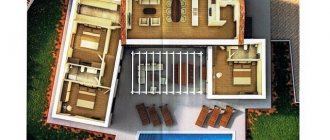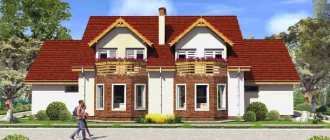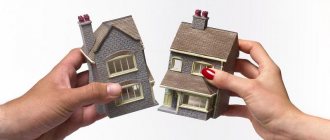How to divide a house into 2 owners
However, even without formalizing the division, any property may well be in shared ownership or co-ownership. This means that it can be legally divided. But you need to act consistently, strictly following the instructions:
- First, legal advice.
- Then complete the necessary documents.
- Afterwards, the allocation of the share of each of the owners in a specific amount.
- Then approval of the project (for 2 inputs).
The land on which the house is located is not touched - the actual division of the plot will take place according to the “scenario” of dividing the house.
When is permission not required?
Not in all cases it is necessary to obtain permission to demolish a dilapidated house. Sometimes it is possible to reconstruct a building without contacting the administration (Clause 8, Article 55.30 of the Civil Code of the Russian Federation).
In what cases can you do without permission to demolish a house:
- Demolition of a dilapidated building while preserving the foundation . A common situation: the owner destroys a dilapidated house and erects a new building in its place. It is quite acceptable to do without permission from the authorities. To do this, you can frame the process not as demolition, but as a “overhaul” or “reconstruction” of the house. True, the new area should not be larger than the old one. Exceeding the “squares” will have to be registered in the BTI.
- Demolition of part of the house . It also does not require permission, but on the condition that the new rebuilt part will be similar in size.
- There is no cadastral registration . It happens that a dilapidated house is not registered in the Rosreestr database. Instead of a demolition permit, you need to notify the BTI, and then issue a technical certificate when building a new house.
Objects recognized as an architectural monument, historical heritage and cultural value stand apart. They are under the protection and protection of the state. The demolition of dilapidated houses with historical value is prohibited by law (clause 13 of article 18 - Federal Law No. 73-FZ of June 25, 2002).
Example:
Brother Yuri and sister Olga received an inheritance from their grandmother. She bequeathed to them an old, dilapidated residential building with a total area of 120 square meters. meters. The windows were broken, there were gaps between the boards, the roof was leaky and needed repairs. The heirs assessed that there was no point in reconstructing the residential building. It’s easier to demolish it and build a new one in its place. Yuri and Olga turned to a local developer for advice. They were offered several options for constructing a new building, including a cottage of similar size while maintaining the current foundation. The developer’s representative advised us to frame the process as “reconstruction.” The brother and sister took out a mortgage, entered into an agreement with the company and began building a new house. Before this, the dilapidated building was demolished as uninhabitable. No permission from the municipality was required.
Legal side of the matter
Any real estate can belong to several owners at once. This is a legal fact. But when arranging separate entrances of one building, it is shared rather than joint ownership that is considered.
Otherwise the project will not be approved. Quite often, a house is divided between two owners by ex-spouses after a divorce. This is how they distribute property acquired during marriage. And this is the most common example when a property has 2 owners.
The Family Code of the Russian Federation provides that ex-husband and wife divide property strictly equally, unless, of course, they provide otherwise in a marriage contract or simply a personal agreement. That is, in the “classic” version, each of the former spouses gets exactly half of the house and, accordingly, half of the land plot under this house. At the same time, real estate objects do not end their existence; they still retain the same address and cadastral numbers.
Important: if a house has 2 owners (regardless of the reasons), each of them is issued a separate certificate of ownership of the house. And a separate certificate of ownership of the land under this house.
First: choosing a demolition method
There are several ways to demolish a building. The use of explosives is used in the case of high-rise, multi-story buildings. Here, of course, you need to contact a specialized organization, which will calculate how much explosives will be needed for demolition, and also correctly plan its placement so that the subsequent destruction process is controlled.
Residential buildings, such as houses, are most often demolished using the traditional method using heavy equipment. Here, undoubtedly, an excavator, a backhoe loader, pneumatic hammers and jackhammers will be in demand. Small buildings on the site: attics, verandas, gazebos, garages, sheds, etc. dismantled manually using electric and gas-powered tools. This method is used when it is impossible to use heavy equipment, limited space, or impossibility of access.
Difficulties of natural division of the house
The Civil Code of the Russian Federation establishes standards for determining the share of each owner of a particular property. And being divided by law, such shares must be documented. In the future, this approach guarantees any of the owners (more precisely, co-owners) the right to independently and at their own discretion dispose of their share in real estate.
But this is theoretical, and in theory everything is simpler than in practice. After all, members of the same family (or former members of the same family, which is even worse) often find themselves in the status of “co-owners”. And there may be conflicts between them that cannot be resolved peacefully, no matter how hard you try.
In addition, any division of property entails certain administrative consequences. As noted above, such property has one address and one cadastral number. How can “sworn” neighbors resolve issues of, say, registering new residents, major repairs and repairs of communications, planning and redevelopment? Through more and more new conflicts and disputes?
To avoid this state of affairs, many seek to register their own share in real estate as a real premises, and this can be done:
- by concluding a special agreement on the exploitation of a residential building and the land underneath it;
- or by allocating a share in the house and land in kind.
Important: each of the above options has its own pros and cons. But most importantly, they cannot always be translated into reality.
Second: ensuring the safety of the demolition site
Delivery of equipment to the work site
For safe mechanical or manual dismantling of the building, the work area must be properly fenced. Information boards will be required. It is also necessary to use fencing tapes and temporary fences at the work site so that strangers do not have access to the danger zone. Proper demolition is not just a technical issue. It is equally important to maintain safety. We often hear about accidents caused by numerous violations in this regard. complies with all requirements and regulations in the field of ensuring the safety of dismantling work
Weather
It is important that demolition work is not carried out in strong winds. Then there is a danger that the building will collapse. When its speed exceeds 10-12 m/s, we immediately stop the demolition. We also ensure that employees do not remain on the lower floors of the building while working. If something spontaneously collapses during the demolition process, it could pose a danger to them. We also make sure that parts of the building that are being destroyed are regularly removed using gutters. Then there will be no debris either on the roof or on the ceilings of the next floors. Since the dismantled structure loses the strength inherent in the design, and the presence of parts of the house being destroyed can lead to uncontrolled destruction
Employee safety
Our demolition workers wear personal protective equipment. If the air is very dusty in the place where demolition is taking place, protective glasses and respirators are used. Everyone must use protective gloves. They protect your hands from possible injuries. Workers performing work at a height of 3 m or more, on the roof or walls of a building, use safety ropes and seat belts.
Organization and management
Each dismantling and demolition site has its own demolition engineer (foreman). From the moment demolition begins, the foreman keeps a log of demolition and dismantling work. He is also responsible for the placement of fencing and must ensure that the area where work is being carried out is properly protected from bystanders, animals and vehicles.
What to do after demolishing a house
After the demolition of the building, you need to invite a cadastral engineer to draw up a house inspection report. Based on this document, a note about the cancellation of the house is made in the technical passport. Next, the owner needs to submit an application to the local branch of the Federal Service for State Registration, Cadastre and Cartography (Gosreestr) to exclude the house from the Unified State Register of Real Estate. The application must be accompanied by a house inspection report, certified by the signature of a cadastral engineer, and a passport of the owner of the building. Now the demolition of the house is legally documented and a new one can be built in its place.
There will be no questions about the new house from the local administration if the old one is demolished correctly
Dismantling half of an old log house
Question:
Help with advice. We live in a 2-apartment wooden house. The house is already old, well, not exactly a wreck, but 40-50 years old. Half of the house is now uninhabited and the village administration allowed us to dismantle it, otherwise it turns into a garbage dump (whoever wants to, climbs in). We started to dismantle the upper beams from the roof on our side, they moved a little away from the wall by 10 cm, but we didn’t notice it at the time, we sealed everything inside, missed it, and for about 10 years there has been no more progress.
We are advised to make a screed, but won't this lead to the opposite effect? There are plastic windows, well, slanted openings of course, but they stand firmly, what if you touch them and everything starts to crawl? And I also want to know if it is possible to cut an opening for a window in the wall shared with the neighbor’s half? And what's the best way to do it? Otherwise, the wall overlooks the road and the garden, I need to see everything.
Ksenia, Khabarovsk region, Nikolaevsky district, village. Red.
Answer:
Hello, Ksenia from Krasnoye!
In cases like yours, there are no clear recommendations and each time you have to approach the solution of the problem according to the circumstances, showing ingenuity and a considerable amount of imagination.
The basic principle that should be observed is “Do no harm!” So that it doesn’t happen that when you start to disassemble the house, or rather half of it, it will begin to warp, deform, even to the point of some parts collapsing.
Therefore, the first step is to inspect all supporting structures, the impact of which can lead to bad consequences.
It often happens that log houses are a single solid structure only when assembled as a whole, and if you remove one wall from it, the second one will begin to fall apart.
Between yours and the other half of the house there must be a strong load-bearing wall installed on a solid foundation. Then it will be possible to separate the second non-residential half by sawing off, disassembling and removing piece by piece all the elements of this half.
But the most important thing in all this is to maintain the rafter system of the house without changes, and since it was made uniform for the entire house, this is the great difficulty of the reconstruction. The separation of the second half can be associated with big problems.
Without a thorough inspection of your house, it is difficult for me to give any recommendations, but those people who advise you to make a screed, as I understand it, are most likely right. But in each specific case this is done, as mentioned above, in accordance with the existing design of the building.
After which, obviously, a pitched roof with its own autonomous separate roof is made over your half, and the second part over the disassembled half is removed in such a way that the rafter system above yours is not disturbed. The attic partition is made of boards and it faces the outside of the street.
Installing a window in a wall, which will turn from internal to external, in most cases does not pose an insoluble problem. If the wall is log or frame, then they either cut it out or take out a section of it, frame it with a frame of boards or timber, and install a window block of the appropriate size. If you have never done such reconstructions, and apparently this is the case, then without the reconstruction work of a knowledgeable builder and his assistants, it is hardly worth getting down to business.
There is another option for the future fate of your house, when the second half of it is completely preserved, the door and window openings are sealed with wooden, or better yet, metal shields to prevent unwanted guests from entering, and the fence on this side is strengthened. And then they drive everyone away either with sticks or with the barking of a dog whose booth is placed nearby.
So see for yourself what suits you best.
In any case - good luck!
Construction in Moscow and Moscow region
We work with a guarantee! Wide range of construction services. Foundation, walls, ceilings, roofing, turnkey! +7 (905) 797-20-34
luxurykomfort.ru
Other questions on the topic of log houses:
- All about log houses
- Replacing logs in log houses
- About caulking log houses
Replacing logs in log houses
- Cost of replacing the top rims of a log house
- Replacing a cut-off wall with foam blocks
- Replace half a wall in a log house
- Replacing a rotten wall of a timber house
- Replacement of lower crowns and cracks in logs
- Replacing the lower logs of an already sheathed house
- Rotten places in logs
- Vertical log house made of round timber
- What to do with rotten logs from a log house
- Rotten crowns in the middle of the wall
- Replacing a log frame with a brick or block
- Replacing the lower crowns of a log house
- Replacing rotten crowns with bricks
- How to strengthen a corner in a log house
- When you need a fifth wall in a log house
- Vibrations in the log house
- Remove the three lower crowns of a log house
- Replacing a wall in a log house
- Replacing the lower crown with brick or foam blocks
- Joining logs of different diameters
- Replace the corner of a log frame with sleepers
- Replacing the lower crowns of a log house with a concrete wall
- Rotten log in a log house
- Restoration and cladding of a timber frame
- Reconstruction of an old log house
- Replacing a rotten corner of a house
- Repair of rotten beams in a log house
- Replacing the lower crowns of a log house with blocks
- Replacing rotten logs of a log house
- Replacement of the lower crown of the house
- Replacement of a main wall made of timber
- Transfer of logs in height in a log house
- Alignment and replacement of the lower crown of the log house
- Replacing rotten logs under the window with blocks
- 2 corners rotted at the level of the log house windows
- Cost of work to replace the top rims of a log house
- The log house is rotting next to the vent
- The wall near the log house in the five-wall building has rotted
- Repair of old logs
- Replacing a log house wall with a foam block
- Replacing the lower crown in a wooden house
- Replacing logs in a log house
- Replacing logs eaten by insects
- Replacing the lower crown of a timber frame
- Replacing the lower crowns in the house
- Replacing the top rotted crown of a log house
- Replacement of the lower crowns of the bath
About caulking log houses
- Caulking log corners
- Rules for caulking a log house
- Caulking of an old log house
- Cold corners in a log house
- Caulking and insulation of a log house
- Caulking a log bathhouse over old moss
- How to caulk a log house covered with clapboard
- Should tow for a log house smell?
- How to fix a chopped pediment
- Re-caulking of a log house
- Caulking and log processing
- Re-caulking the bathhouse with moss
- Calculation of the amount of jute for caulking a log house
- Caulking of a log house lined with bricks
- Caulking tight logs
- Dismantling inter-crown insulation
- Log caulking
- Log house for three years in the open air without a roof
- Re-caulking of a log house
- The basics of caulking a log house
- Caulking and sanding of a log house
- Caulk of a log house from the inside
- Do-it-yourself log caulk
- Caulking of a log house made of rounded logs
- Sanding timber
All about log houses
- Log house made of logs or timber?
- Estimate for finishing the log house
- Strengthen the corner of the log frame from the gun carriage
- The wall of the log house is collapsing
- Forced shrinkage of the log house
- How to fix a crooked timber frame
- The lower crowns of the log house are getting wet
- Correction of a 9-year-old log house
- Rot between the crowns of a bathhouse log
- The frame sank and the window jammed
- Led walls made of profiled timber
- The crown of the log house was turned out
- The dovetail insert moves apart
- Construction of a log house in the South of Russia
- Painting the outside of the log house
- Is casing necessary for small log windows?
- What to do to prevent the log house from twisting during shrinkage
- The quality of the log after 5 years of settling
- Protection of the sauna frame
- Rebuilding an old log house
- Strengthening the fifth wall of the log house
- Bathhouse gables made of rounded logs
- The top crown of the frame was torn out
- How to cut large arches in a log house
- Remaking door and window openings in a log house
- The partition made of logs was torn out
- Repair of an old log house
- Finishing the log bathhouse immediately after installation
- Which interventional insulation to choose
- Lining crowns made of logs with natural stone
- How to beautifully seal shrinkage window openings in a log house
- Tiles and laminate for log floors
- Ceramic tile floors in a log house
- Strengthening the log house
- Align the crown for installation of ceilings
- How to coat a log house after sanding
- Editing the geometry of a log house
- How to install profiled timber in a log house
- Installation of crossbars in a timber house
- New doorway in an old log house
- Reconstruction of a log house
- The bottom beam on the plinth gets wet from the inside
- Treatment of the log house before cladding the outside
- The walls of the log house got wet through and through
- The first crown of a log house made of oak
- Insulation of the stone base of a log bathhouse
- Overcut in the house
- Basement and blind area for an old shrunken log house
- Uneven shrinkage of the frame
- Repair of an old 2-story log house
- What kind of foundation for a 6 by 8 log house?
- How long does it take for a log house to shrink on a pile foundation?
- Increase the height of the log house without removing the roof
- Wind protection between the foundation and the log house
- Problems when lifting an old log house
- Insulation of a log house with sawdust and lime
- How to lay a log house from timber of poor geometry
- Pouring a concrete floor in a log house
- Interfloor ceiling in a log house
- Waterproofing the log house from the foundation
- Renovation of an old log house
- Repair of an old brick-lined log house
- How to strengthen a log house
- When to put a roof on a freshly assembled timber frame
- When to cover a log house with natural humidity
- Support under the log and shrinkage of the log house
- Beetles in logs
- Door in the end wall of a log house
- A team for the construction of a log bathhouse
- The cut of the log on the outriggers of the log house darkens
- Rot on the lower crown of a log house
- Vertical log house
- Which finishing plaster for clay to choose
- Mushrooms on a log house
- Log house without frame and floor beams on slab
- Dry rot of the lower crown of a timber house
- The upper corner of the frame has been removed
- Demolition of a log house wall
- Displacement of profiled timber in a log house
- How to build up log extensions of a log house for a veranda
- The log house was mowed down
- Installing a shrinkage compensator in a finished log house
- Twisted the logs of the log house before assembly
- Log house with nails instead of dowels
- How to protect a log house without a roof from rain
- A set of works on the external finishing of a log house made from central fiber boards
- Repair of a log house after a fire
- Is it possible to put a roof on a log house for the next year?
- Warm joint with sealant for log house
- Insulation and cladding of a log house made of corrugated timber
- Insulation of a log house from the inside
- Concrete floors in a log house
- Shrinkage of log walls old and new
- The procedure for finishing a log house
- How to preserve timber from spring to winter
- What comes first: flooring or door casing
- Dismantling half of an old log house
- Types of beam connections
- Sealing the joint between the roof and the frame from OCB
- Cleaning a log house from old paint
- Connection of two log houses
- Support column in a log house on stilts
- The difference in the shrinkage of a log house between winter and summer felling
- Dismantling and moving a house made of profiled timber
- Supporting floor beams in a log house
- Preparing a log house for winter
- Guarantees when cutting a log house on a plot
- Chop into a bowl or warm corner
- How to lower the ceiling in a log house
- The timber turned blue in the rain
- Preservation of the log house in a non-temporary gathering place
- Consultations on a timber house
- Sheathing of a house made of cylinders without insulation
- Scheme of a log house with outlets and a ridge roof
- How to lay a carriage while lying down
- Reinforced concrete slab on a log frame
- How to assemble a log house from twisted timber
- Repair of a cut in a log house
- Installation of a log house on a columnar foundation
- The chopped gables of the log house are shaking
- Fastening beams in a log house
- The top beam in the log house was driven into the screw
- How to cover a timber façade
- Waterproofing the frame of an old house from the foundation
- A log house without nails is being pulled apart
- Sheathing a log house
- Cutting the lower crown in the log house
- Settlement of a log house made of used timber
- The log house rotted in the castles
- The corners of the log house are rotting
- How to strengthen a log house
- Work plan for interior finishing of the log house
- Log processing procedure
- How to lay a log house in the rain
- Cut the lower crowns of the log house
- Sheathing a log house immediately after construction
- Heating and windows in a new log house
- Processing the crown of an already built house
- Painting a timber house
- Blind area and shrinkage of the log house
- How to enlarge a house made of timber
- Connecting a timber house with a brick extension
- Finishing a timber frame with jute rope
- Diameter of a log for a permanent home
- Treating the log house with an antiseptic during assembly
- Reconstruction of a wooden house
- Connecting timber in cuttings
- Protection of the ends of the timber at the corners of the log house
- How to connect two log houses together
- Cutting a balcony doorway in a log house
- When to casing a newly assembled log house
- Insulation of gables made of lining
- Gaps between the logs of the log house pediment
- How to preserve logs before cutting a log house
- Raise the frame to increase the ceiling height
- Methods for joining timber in the walls of a log house
- Raise a log house to increase the underground floor
- Cladding a log house with clapboard before shrinking in winter
- When to remove the compensating jacks of a log house
- Log house for three years in the open air without a roof
- How to make a cut in a log house
- Make a house from an old bathhouse (timber)
- Moving the log house to another location
- Log house hanging on dowels
- The fifth wall in a log house made of smaller timber
- Should I paint the backing board in a log house?
- Remove mats to increase log ceilings
- The log house does not match the foundation
- Ceiling mats in the log house
- Construction from fire monitors
- How to remove bark from an already assembled aspen log house
- Transporting an old log house
- Connecting internal timber walls with external ones
- How to repair cracks in a log
- Gap between log and foundation
- Alignment of the first crown of the log house
- Stages of arrangement of the assembled log house
- Treatment of the log house after installation in the summer
- Processing the ends of the frame from the outside
- The log house floated - the walls moved
- An old wooden house sank
- Leveling the crowns when assembling a log house
- How to close the opening between the log house and the foundation
- How to straighten a log house
- Sheathe a log house with protrusions with corrugated sheets
- How to process the ends of a log house
- Collecting the first crowns of a timber frame
- Riser frame
- Preservation of the log house during assembly in rainy times
- Forgot to waterproof the log house from the foundation
- Installation of log shrinkage compensators
- Interventional gaps in a house made of profiled timber
- Gaps between logs in a house
- Communications and finishing in a timber house
- Precision when cutting log houses
- Which log house will be warmer?
- Log house made of timber 200 by 120
- Old log house - reconstruction or demolition
- Partitions in a log house
- Internal partition in a log house
- Beginning of finishing of shrunken timber frame
- Double timber construction technology
- Processing the log house from the outside
- Log shrinkage process
- The walls of the log house collapse during shrinkage
- Insulation of a log house from the inside
- How to build a house from sleepers
- The logs were kicked out of the log house
- Supports (pillars) instead of crosscuts in a 9x10 house
- Do-it-yourself timber log house without experience
- Preservation of a house made of rounded logs for the winter
- Embed additional beams into the frame
- Backing crown - installation tricks
- Log house on brick walls
- Sequence of work in the log house
- How to make a load-bearing partition in a log house
- The log house got wet during assembly
- How to seal cracks in a log house
- Align the vertical wall of a log house
- Vents in timber on foundation
- Timber 200 by 200 construction nuances
- The log house turned blue, what should I do?
- How to seal cracks in cutouts from the outside
- You can live on the second floor of a log house for shrinkage
- Replace rotten logs with mortar
- A non-load-bearing log has shrunk
- Replacing logs with boards in a house project
- Vertical supports in a log house for shrinkage
- Does a large log house need recutting?
- Metal tiles on a non-shrunken log house
- Permissible gaps between timber crowns
- Gaps in log beams
- Replacing parts of rotten logs in a log house
- The logs of the log house are shaking
- The log house was poorly assembled
- The gap between the log log and the foundation
- Protect an unfinished log house for the winter
- How to save a log house without a roof
- Log finishing service
- Assembling a profiled log house in the rain
- Gaps when fastening profiled timber
- Sealing cracks in a bathhouse
- Processing timber with a blowtorch
- Butt beam - is it reliable?
- The wall of the log house is littered
- How to align protruding ends in a built timber house
- Transferring beams in a log house in height
- The corners of the log house disappear from the timber during assembly
- The log house is wet, what should I do?
- Does a log house need a fifth wall?
- How to assemble a log house 10 by 11
- Restoring a log house after a fire
- Processing of a log house made of rounded logs
- Extension of a log house when replacing the roof
- Sand under the crowns for insulation
- Methods for lifting a bath to replace the crowns
- Impregnation of the log house inside and out
- The façade of the log house leaned
- Log shrinkage - problems
- Treatment of timber against bugs
- The smell in the house is from sleepers
- How to preserve the light color of a fresh log house
- Estimate for a house made of timber 7 to 9
- Treatment of exposed ceiling beams
- Strengthening the corner of a log house
- What is the dowel pitch?
- Protection of the lower crown of the log house
- How to check the diagonals of a log house
- Which timber to choose, square or rectangular?
- Spruce and pine log house
- Sequence of work when finishing a timber house
- Insulate an aspen log house from the outside
- How to install a casing on a log house
- What to put between the crowns
- Should I trim the paws of a log house?
- What is the best way to impregnate a log house?
- Window opening in a log house - how to seal it
- Gaps in the assembled frame
- Support pillars in a timber house
- How to move the 5th wall in a log house
- Ants and the lower crown of the house
- Sanding and processing of the log house after installation
- Barked or planed log for log house
- Repairing the corner of a log house of an old wooden house
- Should window openings in a log house be closed when it is in storage?
- Consultation on the size and shape of the log house
- Questions about construction from profiled timber
- Log house and foam block on a single slab
- Preparing an unfinished log house for winter
- Longitudinal cuts in a log house
- Cracks in the ends of logs
- Should I paint a log house with tikuril?
- Strengthening the corners of the log house
- How to secure a cross beam in a log house
- Ventilation gap between insulation and frame
- Moss or tow for building a log house
- Shrinkage of a timber house
- Fifth wall in the log house
- How to raise a 6 by 6 log house
- Distance from the corner of the frame to the windows or doors
- How to cut off the protrusions of the corners of a log house
- Log house without nails
- How to clean a linden bathhouse from darkening
- Impregnation of a log house with fire-bioprotection
- Velo log house
- Questions about cutting a bathhouse after installation
- Painting a log house
- Blackness between the crowns of the log house
- Types of cutting corners of half beams or carriages
- Attaching beam supports to a log wall
- Strengthening logs in a log house 7 meters long
- How to sort through the log gables of a log house
- The beam was squeezed out of the wall
- Is a matitsa needed in a 3 by 3 m bathhouse?
- Priority work after installing the log house
- Entrance door in a log house
- Maintaining the level when assembling the log house
- The corner of the log house and the lower log have rotted
- The sequence of finishing a timber frame
- Insulation of a settled log house
- Restoring a burnt larch frame
- Quality of a 40-year-old oak log
- Permanent roof on a newly assembled log house
- Cracks in logs
- What time of year is it better to cut a log house for a bathhouse?
- What and how to make partitions inside a log house
- Ceiling beams in a timber frame
- Installation of a metal door in a log house
- The crown molding of a log house
- Questions about assembling a log house at home
- Turnkey log house for a season - is it possible?
- Arrangement of the subfloor in a rounded log house
- Common roof for a new log house and its extension
- Ventilation system in the log house underground
- How much does it cost to change the lower crowns of a house?
- Finishing the log house after shrinkage
- Reinforcement as a dowel for a log house
- What to rest the floor joists on in a log house
- Attaching timber to a log frame
- Cover an old house with a new frame
- Extension made of foam blocks to a house made of timber
- Wet lower rims of a new timber frame
- House made of sleepers
- How to cover a log house on screw piles with bricks
- How to strengthen the motherboard in a log house
- Birch log house
- Sauna log - pine or aspen
- The lower crowns of a larch frame as a plinth
- Adjusting anchors for shrinkage of the log house
- How to properly assemble a log house
- Octagonal timber frame
- Is a fifth wall needed in a log house?
- An alternative to dowels when assembling a log house
- Problems after shrinkage of the log house
- What to make partitions from in a log house
- Tongue-and-groove slabs as walls in a log house
- Insulation of the log house inside
- How to strengthen floor joists in a timber frame
- Log houses in Kolomna
- House made of timber or frame house
- Insulation of a log house from the inside
- Work plan after shrinkage of the log house
- Squeezed logs out of the log house
- Where to start after installing a log bathhouse
- Rounded log with Finnish profile
- The timber frame is spreading
- How to align the geometry of a log house
- Large gaps between logs
- Are dowels needed for profiled timber?
- Is it worth overpaying for profiled timber?
- Repairing the corners of a log house
- How to cover an unfinished log house for the winter
- The beam bends out of the log house
- Construction of a log house in the rain
- Processing and insulation of external walls of a log house made of timber
- How far can the outer ends of the logs be trimmed?
- Ceiling beams 7.5 m in a house made of timber
- How to attach a room attached to a house
- Technology for assembling a log house from timber
- Waterproofing log walls outside
- Replacement of the lower crown of an old house
- Interior finishing of the corners of the log house in the paw
- Dry brown rot in log timber
- Shrinkage of timber frame
- Roof on only installed log house
- How to fill the gaps between the log house and the outbuilding
- When to install a log house for a house
- How far can the ends of logs be trimmed?
- When should a log house be treated with impregnation?
- Cutting the end corners of the log house
- Leveling timber in a log house
- Protection of the log frame from the outside
- Replacing log walls with stone
- How to seal the gaps between the foundation and the log house
- How to cover a timber house
- How and with what to seal the gap between the foundation and the log house
- Bark on logs - to remove or not?
- Sandwich panel or log house?
- Preservation of log wood
- How to change the lower crown
- Settlement of a log house made of laminated veneer lumber
- Log house repair
- What kind of foundation is needed for a log house made of 9 by 12 m timber?
- How much timber is needed for a log house 9 by 12 meters
- Foundation for a log house with chopped gables
- When to put a roof on a log house
- How to seal cracks in a timber frame
- Log house on the spring
- Preparing a log house for winter
- Oak backing for the lower crown of the log house
- Log house repair
- Photo of a chopped log house
Construction in Moscow and Moscow region
We work with a guarantee! Wide range of construction services. Foundation, walls, ceilings, roofing, turnkey! +7 (905) 797-20-34
luxurykomfort.ru
Construction in Moscow and Moscow region
We work with a guarantee! Wide range of construction services. Foundation, walls, ceilings, roofing, turnkey! +7 (905) 797-20-34
luxurykomfort.ru
Construction in Moscow and Moscow region
We work with a guarantee! Wide range of construction services. Foundation, walls, ceilings, roofing, turnkey! +7 (905) 797-20-34
luxurykomfort.ru
Log houses and their maintenance
All questions to Semenych about construction
Semenych (author of materials)
Our site is regularly updated with interesting and unique materials and articles on the topics of lumber, building materials and works, the author's opinion and knowledge of a real coven with more than 15 years of experience are provided. There is a section - funny stories of shabashniks. If you would like to receive information about this, subscribe to our website's newsletter. We guarantee that your address will not be shared with third parties.
Apartment renovation in Moscow and Moscow region
We work with a guarantee!
Wide range of repair work. Professional craftsmen.
+7 (905) 797-20-34
luxurycomfort.ru
| Country house | Bath |
| For the dacha | Tool |
| Materials | Tales |
| Foundation | Log houses |
| Roofs | Insulation |
| Walls | Siding |
| Floors | Cellars |
| Attics | Doors windows |
| Stairs | Extensions |
| Wells | Toilets |
| Balconies | Loggias |
| Condensate | Flooding |
| Fences | Kennels |
| Sidewalk | Birdhouse |
| Adobe | Carts |
| Garages | Barn |
| Greenhouses | Bath |
| Swing | Brazier |
| Shower | Horizontal bar |








